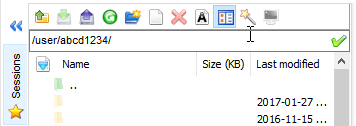Difference between revisions of "Login"
| Line 1: | Line 1: | ||
== Login nodes == | == Login nodes == | ||
The cluster provides four login servers that allow | The cluster provides four login servers that allow you to connect to the cluster (e.g. for submitting and monitoring jobs or editing of files). The login servers can be reached using the hostnames | ||
carl.hpc.uni-oldenburg.de | carl.hpc.uni-oldenburg.de | ||
eddy.hpc.uni-oldenburg.de | eddy.hpc.uni-oldenburg.de | ||
Revision as of 07:20, 16 February 2017
Login nodes
The cluster provides four login servers that allow you to connect to the cluster (e.g. for submitting and monitoring jobs or editing of files). The login servers can be reached using the hostnames
carl.hpc.uni-oldenburg.de eddy.hpc.uni-oldenburg.de
Using either of the two hostnames will connect you to one of the login servers which have the hostnames
hpcl00[1-4].hpc.uni-oldenburg.de
and are assigned in an round-robin fashion (to distribute the load on the login servers). You can also use these hostname to login to a specific server but should only be used when needed.
Intranet
If you want to connect to the cluster from a windows computer, you can use your favorite ssh client (MobaXterm, PuTTY, OpenSSH, WinSCP) on Windows-Computers or the command line on Linux-computers.
Connect to CARL/EDDY using MobaXterm
"MobaXterm" is the recommend way to connect to the cluster from a Windows computer. The following lines will describe the basic usage of the program.
The newest version of MobaXterm can always be found here: Download
After downloading and installing you are ready to use the program. Once you opened it, click on "Session" in the top left corner. Fill in the following informations:
If you want to connect to EDDY, simply replace "carl" with "eddy" (-> eddy.hpc.uni.oldenburg.de).
As always, replace "abcd1234" with your own username. There are many settings that can be modified, for this example we will not change them though. Confirm by clicking on "OK". A new tab will open and you will be prompted to enter your password.
After typing it in and confirming it with ENTER you are succesfully connected to the cluster.
You will probably immediatly see a big difference to other ssh clients: you can easily browse through the folders on the clusters without using the command line. The sidebar will look like this:
You can even drag&drop files on the cluster with this sidebar, which makes handling files very easy.
Connect to CARL/EDDY using PuTTY
We recommend to use "mobaXterm" since it offers more features and is more user-friendly. Nonetheless its your choise and if you want to use PuTTY you can follow these instructions:
Download the latest version of PuTTY from this link: Download
Enter the url "carl.hpc.uni-oldenburg.de" under the field "Host Name (or IP adress)":
Make sure the Port is set to "22" and the connection type is "SSH". Confirm by pressing the button "Open".
A new windows will popup and you have to type in your username (e.g. "abcd1234):
After you confirmed by pressing ENTER, you will be asked for your password. Type it in and confirm with ENTER again. You are now connected to the cluster.
If you want to connect to EDDY, simply replace "carl" with "eddy" (-> eddy.hpc.uni.oldenburg.de).
If you want to copy files from or on the cluster, you will have to use the program "WinSCP".
Connect to CARL/EDDY using the command line
Users of CARL can connect by typing:
ssh abcd1234@carl.hpc.uni-oldenburg.de
Similarly, users of EDDY login by typing:
ssh abcd1234@eddy.hpc.uni-oldenburg.de
If you want to use graphical applications on the login nodes (e.g. an editor like gedit) you need to enable X-forwarding:
ssh -X abcd1234@carl.hpc.uni-oldenburg.de
Internet
First, you have to establish a VPN tunnel to the University intranet. After that, you can login to CARL or EDDY via ssh as described above. See the following instructions on how to setup the VPN tunnel:
Windows
Download the Cisco-VPN-Client from this web site and install it following the instructions of the IT Services.
When you start a VPN tunnel by pressing connect, you will be prompted for your university user name and password.
Linux
First you may need to install some additional packages. This can be done e.g. with the command:
sudo apt-get install network-manager network-manager-gnome network-manager-vpnc vpnc
You will be prompted for the password on your local machine. If you are using KDE install network-manager-kde instead of the -gnome one.
To setup the VPN connection click on the network status (upper left of your desktop) and select VPN connection-->Configure VPN. Now you can either select Add or Import. After Add enter the information manually as described in the instructions of the IT Services. For Import you first need to download the PCF-File and after importing it enter your user name and password.
To connect click on the network status again and select the VPN connection you just configured.



